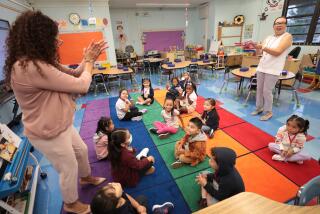School Boards Discuss How to Reduce Class Size
Scrambling to capitalize on state dollars earmarked for reducing class size, the Moorpark school board Monday will consider hiring at least 30 new teachers for the upcoming school year, at a predicted cost of about $1.5 million.
School district officials estimate that the state--chipping in $650 for each of Moorparkâs 1,700 first-, second- and third-graders--would cover three quarters of the cost to hire the teachers.
âNow is the time,â said Frank DePasquale, the Moorpark Unified School Districtâs assistant superintendent for instruction and support services. âWe have a great opportunity to make some systemic changes.â
Ventura school officials are also meeting next week to consider ways to reduce class size, but acknowledge the district may not have the space or the money to implement such reforms for all of its youngest students.
School districts countywide have been spurred to action by Gov. Pete Wilsonâs recent $771-million initiative to limit class size in kindergarten through third grade to 20 or fewer students for each teacher. With applications for state funding due Nov. 1, local school boards are hammering out plans to hire more teachers and to ease crowding by adding portable classrooms.
The class-size reduction initiative leaves many options open to the school boards. Each panel must weigh whether to shrink class size for all the primary grades. Additionally, the boards in overcrowded districts must grapple with whether to create 40-student classes with two teachers or use portable classrooms to accommodate the students.
In the 6,500-student Moorpark district--where the student to teacher ratio typically runs 30 to 1--district officials intend to adopt a âtransitional modelâ come autumn, school board President Clint Harper said.
Under a proposal crafted by Moorpark Supt. Tom Duffy, two classroom teachers and one roaming teacher would be assigned to every two 30-student classes in the fall. By the second semester, the district would likely purchase enough portable classrooms for each teacher to have a 20-student class.
âItâs a lot of work, but itâs certainly worth it,â Harper said.
The logistics of portable classrooms--how many will be needed and how much they will cost--have yet to be determined, DePasquale said.
In the 17,000-student Ventura Unified School District, officials Tuesday will review all options before deciding what direction to take, explained school board President Cliff Rodrigues.
At this point in time, the district is unsure whether to reduce class sizes for only the first grade or for all of the grades eligible. Initial estimates are that the first option would require hiring 24 new teachers and installing an equal number of portable classrooms, with the district paying $223,650 for salaries and benefits beyond state funding.
For the second option, the district will need another 65 new teachers and portable classrooms, with a $610,500 price tag.
While class-size reduction is universally hailed as a good idea--allowing for more one-on-one interaction and custom-crafted instruction--educators are already encountering a handful of nagging questions: What if state money dries up in a few years and districts are left holding the funding bag? Or what if there arenât enough qualified teachers to fill the open positions at all schools?
Unperturbed, Moorparkâs DePasquale said the state money is expected to continue for the foreseeable future. And a possible teacher crunch doesnât keep him awake at nights.
âWeâre all very excited,â he said. âWeâve been waiting a long time for this kind of change in our schools.â The details, he added, will fall into place.
More to Read
Sign up for Essential California
The most important California stories and recommendations in your inbox every morning.
You may occasionally receive promotional content from the Los Angeles Times.










